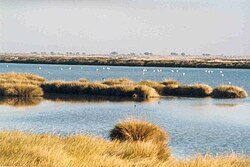Methods of identification
Isotopes
Examining the composition of stable isotopes in the water found in soil, rivers, groundwater, and xylem (or vein systems) of vegetation, using mass spectroscopy, which measures and sort the masses in a sample, along with data on the changes in groundwater depth coupled with the time and vegetative rooting patterns, shows spatial changes over time in the use of groundwater by the vegetation in its respective ecosystem. [1]
Plants
A groundwater-dependent ecosystem can also be inferred through plant water use and growth. In areas with high rainfall groundwater reliance can be seen by monitoring the water use made by the plants of the ecosystem in relation to the water storage in the soil of the area. If the use of water in the vegetation exceeds that of the water being stored in the soil it is a strong indication of groundwater utilization. In areas of prolonged drought the continuation of water flow and plant growth are highly indicative of a groundwater reliant area. [1]
Remote Sensing is the scanning of Earth by satellite or aircraft to obtain information. [2] GIS is a system designed to capture, store, analyze and manage geographic data. [3] Together the data collected (such as elevation and bore holes measuring groundwater levels) can very accurately predict where groundwater-dependent ecosystems are, how extensive they are, and can guide field expeditions to the right areas for further confirmation and data collection on the GDEs. [4] [5]
This page is based on this
Wikipedia article Text is available under the
CC BY-SA 4.0 license; additional terms may apply.
Images, videos and audio are available under their respective licenses.


